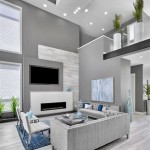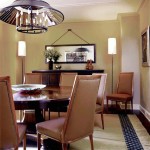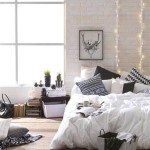How to Decorate a Plain Wall in Your Living Room
A plain wall in a living room can often feel like a missed opportunity, a blank canvas yearning for personal expression and visual interest. While minimalism certainly has its appeal, a completely bare wall can sometimes feel stark, incomplete, or even boring. Transforming a plain wall into a captivating focal point can dramatically elevate the overall aesthetic of the living room, adding character, depth, and personality to the space. There are numerous approaches to achieving this, ranging from simple and budget-friendly solutions to more elaborate and permanent installations, each offering a unique way to enhance the ambiance of the room.
The process of decorating a plain wall should begin with careful consideration of the existing decor, the room's size and layout, and the desired aesthetic. The goal is to integrate the wall decoration seamlessly into the overall design scheme, creating a cohesive and harmonious environment. This involves taking into account factors such as the color palette, furniture styles, and the room's natural lighting. Overlooking these aspects can lead to a disjointed and unappealing result.
Furthermore, it is important to consider the function of the living room. A formal living room might benefit from a more sophisticated and elegant wall decoration, while a casual family room might lend itself to a more relaxed and playful approach. Understanding the room's primary purpose will help guide the selection of appropriate decorative elements and ensure that they complement the overall atmosphere.
Artwork and Wall Hangings
One of the most classic and versatile ways to decorate a plain wall is through the use of artwork and wall hangings. From paintings and prints to tapestries and sculptural pieces, the options are virtually limitless. The key is to select artwork that resonates with personal taste and complements the room's existing decor. Size and scale are also important considerations. A large, impactful piece can serve as a dramatic focal point, while a gallery wall composed of smaller pieces can create a more eclectic and personalized display.
When choosing artwork, consider the color palette of the living room. Opt for pieces that incorporate colors that are already present in the space, either as a primary color or as accents. This will help to create a sense of visual harmony and prevent the artwork from feeling out of place. It is also important to consider the style of the artwork. A modern living room might benefit from abstract or minimalist pieces, while a traditional living room might lend itself to more classic or representational works.
Creating a gallery wall involves careful planning and arrangement. Start by laying out the pieces on the floor to experiment with different configurations. Consider varying the sizes, shapes, and styles of the artwork to create a more dynamic and visually interesting display. Maintain consistent spacing between the pieces to create a sense of order and cohesion. The height at which the gallery wall is hung is also important. Ideally, the center of the gallery wall should be at eye level.
Beyond traditional framed artwork, other types of wall hangings can add texture and visual interest to a plain wall. Tapestries, macrame wall hangings, and woven textiles can introduce a bohemian or eclectic touch to the living room. These types of wall hangings can be particularly effective in adding warmth and character to a minimalist or modern space.
Mirrors are another excellent option for decorating a plain wall. They not only add visual interest but also help to reflect light and create the illusion of more space. A large statement mirror can be a dramatic focal point, while a collection of smaller mirrors can create a more eclectic and personalized display. Consider the shape and style of the mirror to ensure that it complements the room's overall decor. Mirrors with ornate frames can add a touch of elegance, while mirrors with simple frames can create a more modern and minimalist look.
Shelving and Storage Solutions
Integrating shelving and storage solutions into the wall decoration is a practical and stylish way to transform a plain wall. Shelving can provide a platform for displaying books, decorative objects, plants, and other personal items, adding both visual interest and functionality to the living room. A variety of shelving options are available, ranging from floating shelves and built-in bookshelves to modular shelving units and open shelving systems. The choice will depend on the room's size, layout, and the desired aesthetic.
Floating shelves are a popular choice for creating a minimalist and modern look. They are easy to install and can be arranged in a variety of configurations. Floating shelves are particularly effective in smaller living rooms, as they do not take up much space. When styling floating shelves, consider varying the heights and depths of the objects to create a more dynamic and visually interesting display. Group items together in odd numbers for a more balanced and harmonious arrangement.
Built-in bookshelves offer a more permanent and substantial storage solution. They can be customized to fit the specific dimensions of the wall and can provide ample storage space for books, media, and other items. Built-in bookshelves can be a significant investment, but they can also add considerable value to the home. When designing built-in bookshelves, consider incorporating elements such as lighting, molding, and decorative accents to enhance their aesthetic appeal.
Modular shelving units offer a flexible and adaptable storage solution. They can be easily reconfigured to meet changing needs and can be customized to fit a variety of wall sizes. Modular shelving units are available in a wide range of styles and materials, making them a versatile option for any living room. When selecting a modular shelving unit, consider the weight capacity of the shelves and the overall stability of the unit.
Open shelving systems can create a more airy and open feel in the living room. They are particularly effective in displaying collections of decorative objects or plants. Open shelving systems can be made from a variety of materials, such as wood, metal, or glass. When styling open shelves, consider incorporating a mix of textures and colors to create a visually interesting display.
Textural Elements and Architectural Details
Adding textural elements and architectural details to a plain wall can dramatically enhance its visual appeal and create a sense of depth and dimension. This can be achieved through various techniques, such as installing paneling, wainscoting, or shiplap, or by applying textured paint or wallpaper. These elements can add character and sophistication to the living room, transforming a plain wall into a statement feature.
Paneling and wainscoting are classic architectural details that can add a touch of elegance and formality to the living room. Paneling typically covers the entire wall, while wainscoting covers only the lower portion of the wall. Both paneling and wainscoting can be made from a variety of materials, such as wood, MDF, or PVC. The choice of material will depend on the desired aesthetic and the budget.
Shiplap is a type of wood paneling that is characterized by its overlapping boards. Shiplap has become increasingly popular in recent years, particularly in farmhouse and coastal-style homes. Shiplap can be installed horizontally or vertically, and it can be painted or stained to match the room's decor.
Textured paint is a simple and affordable way to add texture to a plain wall. Textured paint is available in a variety of finishes, such as sand, stucco, and popcorn. Applying textured paint can create a subtle yet noticeable difference in the room's overall appearance. It's important to practice proper application techniques to achieve a professional-looking result.
Wallpaper is another versatile option for adding texture and pattern to a plain wall. Wallpaper is available in a wide range of colors, patterns, and textures, making it a versatile option for any living room. Consider using a textured wallpaper, such as grasscloth or embossed wallpaper, to add depth and dimension to the wall. A bold wallpaper pattern can create a dramatic focal point, while a subtle wallpaper pattern can add a touch of sophistication.
Another way to add texture is by using natural materials. Stone veneer or brick accents can introduce a rustic and earthy element to the living room. These materials can be used to create a fireplace surround, an accent wall, or a decorative niche. Natural materials can add warmth and character to the space, creating a cozy and inviting atmosphere.
Ultimately, decorating a plain wall in the living room involves careful planning, creativity, and attention to detail. By considering the room's existing decor, the desired aesthetic, and the function of the space, it is possible to transform a plain wall into a captivating focal point that enhances the overall ambiance of the living room. Whether through artwork, shelving, or textural elements, the possibilities are endless, allowing for personal expression and creating a space that is both visually appealing and functionally satisfying.

How To Decorate A Large Blank Wall

10 Ways To Fill A Blank Wall How Decorate

7 Ways To Style A Big Blank Wall

How To Decorate A Big Blank Wall Sanctuary Home Decor

Sharing My Easy Decorating Tips For Filling A Blank Wall Space Floating Shelves Living Room Home Decor Trends

How To Decorate A Big Blank Wall Sanctuary Home Decor

8 Low Cost Ideas To Bring Life Blank Walls

7 Ways To Style A Big Blank Wall

9 Ways To Decorate A Blank Wall

How To Decorate A Large Wall Home Living Room Interior Design Decor Inspiration







